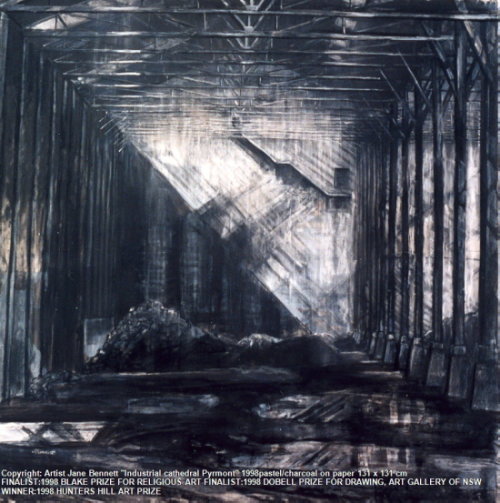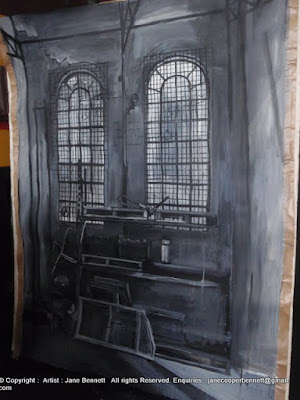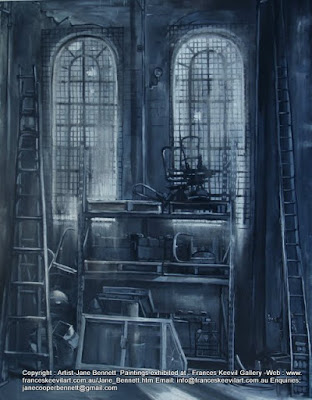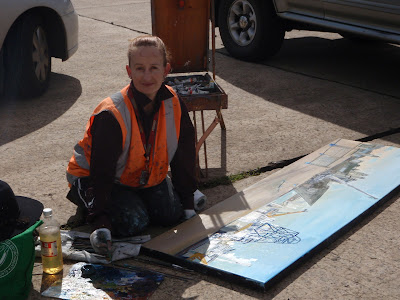Group Exhibition
June 13 - July 17 2011 at the Frances Keevil Gallery :
Exhibited 2010 exhibition "Closing the Gap" Frances Keevil Gallery COLLECTION : MITCHELL LIBRARYThe ultimate bird’s eye view of Sydney – the top of the western pylon of the still unfinished New Glebe Island Bridge provided me with majestic panoramas of Harbour, Bridge & City on the east.
Now the old White Bay Hotel has been burnt down in mysterious circumstances, and subsequently demolished. The entire Bays precinct stretches from Blackwattle Bay, Glebe in the West, through White Bay and Glebe Island wharf, all the way to Balmain in the east. This huge expanse of former maritime industries faces unprecedented change in the near future, which I am poised to record.
P117 'Industrial Cathedral' 1998
charcoal on paper 131 x 131 cm
Available for sale
WINNER : 1998 HUNTER'S HILL OPEN ART PRIZE
FINALIST: 1998 BLAKE PRIZE FOR RELIGIOUS ART
FINALIST : 1998 DOBELL PRIZE FOR DRAWING, ART GALLERY OF NSW
EXHIBITED : 1998 - 2000 Blake Prize Touring Exhibition Touring the Regional Galleries of Australia
Drawn at the Cooperage, C.S.R. Refinery, where they made the barrels for the rum at the Distillery.
The Cooperage was a trio of connected saw-tooth warehouses behind the cranes where the ships used to dock.
I remember a giant mound of sugar inside the eastern shed. Some of the workers said (I hope as a joke !?) that they used to go for toboggan rides down it during smoko! Whether or not this was a joke, for many years afterwards I avoided eating sugar if possible - especially brown sugar!
By this time LendLease had demolished all the cranes on the dock and many of the other structures surrounding. The tin roof had gone and the skeletal framework reminded vaguely me of boatbuilding.
This drawing focuses on the mysterious patterns of shadow made by the fall of light. The cavernous space & rows of columns reminded me of the interiors of cathedrals & ruined abbeys. The wall at the back was the famous butter-yellow Pyrmont sandstone, which has been quarried to decorate the best loved historic Sydney buildings such as the Australian Museum, the Sydney Post Office, the University of Sydney. At sunset the sandstone rock face caught the last rays of light & the derelict warehouse was transformed.
In this series I painted many oils on canvas and board, and a few ink wash drawings on paper. The image of this area haunted me for several years, and I decided that I needed to create a drawing on a monumental scale while it was still there.
Now this building is the site of the "Cooperage cafe", servicing the new residents of LendLease's upmarket Jackson's Landing development.
I chose this image as the banner for my blog "Industrial Revelation"
For more information see My Pyrmont page in this blog
Related posts
Looking over the overlooked-Urban decay in Pyrmont
To the Point
Wrong side of the tracks - Darling Island Bond and Free
Paintings of Pink pubs - Painting the Jolly Frog Part 2
Not the Writers Festival- Exhibition of Pyrmont Paintings by Jane Bennett at 2013 Pyrmont Festival
We like sheep - Waite and Bull Building 137 Pyrmont Street
Marine art exhibition at Australian National Maritime Museum
Pyrmont Sandstone - The Lizards of Oz







































